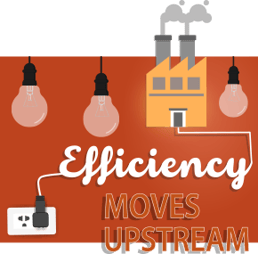- Home
- Services
- Hi-Line Engineering
- About
- Careers
- Contact
- Requests For Proposals
Efficiency Moves Upstream | GDS Associates | Newsletter
by GDS Associates, Inc | February 8, 2017 | Newsletter - TransActions

By Josh Duckwall, GDS Project Manager
The role of energy efficiency in the modern utility industry is very simple. The goal is to incent utility customers to invest in a more efficient product or service than they normally would, something better than the business as usual case. The problems begin if a program incentivizes too little and it ends up with no participation and no measurable demand reduction or incentivizes too much and the program becomes oversubscribed and unattainable.
Historically, the onus to improve efficiency has been marketed downstream to the end user, residential or commercial/industrial participants, who either take advantage of utility buy-down programs at the point of purchase or submit rebate applications for facility improvements. While these are highly effective methods to reduce the carbon footprint and total operating cost of a generating utility, a more aggressive and direct approach to target the energy production sources and electric distribution facilities efficiency is gaining in popularity throughout the country. As utilities work to find new markets to target for achieving efficiency goals, this generation and distribution sector remains largely untapped for incentivizing.
GDS worked with the Minnesota Department of Commerce (“MDC”) to develop a number of measures for inclusion in the stateTechnical Reference Manual (TRM) that outline achievable energy savings for certain energy infrastructure and generation improvements. Through a stakeholder consensus effort that included utilities and advocacy groups, the MDC determined that there are quantifiable efficiency gains available in certain upgrades that are above and beyond typical “business as usual” type utility infrastructure maintenance activities. Now on to the more difficult parts of the program, assigning deemed savings values that are justified, from the facility level all the way back to the generation plant and any significant point in between.
So how did the MDC showcase intentional energy savings that far upstream?

Involve the Stakeholders
Stakeholder groups are the most important voice when determining what is both technically accurate and widely valuable to Minnesota ratepayers and citizens. A successful project of this type begins by creating a master list of all of the potential measures in the applicable sector such as transformer replacement, reconductoring lines, turbine resizing, all the way down to VFDs on pumps and cooling tower fans. The open forum allows for a documented record of opinion where the ratepayers can agree or disagree with the value in upstream improvements, along with the basis of any concerns. Involving the stakeholder groups through the use of multiple forums throughout the process has given the Minnesota project team a boost in speed for moving the measures forward, bringing any issues with policy, rate recovery, or calculation methodology to the front of our project timeline. Past experience has shown these conversations are typically fruitful and productive, even in instances where stakeholders may sit on two different sides of an issue such as the proposed EPA Clean Power Plan and potential ways to prepare for it.
Fortunately, the basic design of infrastructure equipment has been vastly unchanged in recent decades and the methods used today are rooted in solid engineering principles, making the efficient case very easy to define.
Math
 Lots of it. The idea that a TRM measure is going to enter the boardroom discussion on ROI or capital project planning at a utility generation scale is a grand one. In addition ensuring that the savings will not be double counted down the road is tricky. As with any TRM measure, each utility infrastructure upgrade needs a defined measure life, common capital costs and operating costs as defaults, associated savings, applicability definitions, and a litany of other variables that have to align with the remainder of the TRM. Almost immediately there are problems with trying to wrangle in a seemingly endless list of baseline options as the projects are highly differentiated. Fortunately, the basic design of infrastructure equipment has been largely unchanged in recent decades and the methods used today are rooted in solid engineering principles, making the efficient case very easy to define.
Lots of it. The idea that a TRM measure is going to enter the boardroom discussion on ROI or capital project planning at a utility generation scale is a grand one. In addition ensuring that the savings will not be double counted down the road is tricky. As with any TRM measure, each utility infrastructure upgrade needs a defined measure life, common capital costs and operating costs as defaults, associated savings, applicability definitions, and a litany of other variables that have to align with the remainder of the TRM. Almost immediately there are problems with trying to wrangle in a seemingly endless list of baseline options as the projects are highly differentiated. Fortunately, the basic design of infrastructure equipment has been largely unchanged in recent decades and the methods used today are rooted in solid engineering principles, making the efficient case very easy to define.
In theory, as long as the utility uses the TRM set of algorithms, they are protected from evaluations that question the accuracy of the results, and the need for unique engineering calculations for each rebate application. MDC took the design of the algorithms and determination of the background source information very seriously to make implementation and evaluation a non-issue.
Modernize the Approach

The Minnesota TRM project is employing “Smart Measure” formatting, a design approach provided by a sub-contractor to the state of Minnesota, Energy Platforms. Historically, TRM documents are complicated and lengthy books without a standard format, making it very difficult for a utility planner to determine the deemed savings of a measure and increasing the potential for calculation error. One viable solution is to build these infrastructure measures in a cloud based system where the algorithms and variables are pre-loaded into the database for the utility client. Doing so removes a large portion of the error risk and allows the State or region commission the opportunity to adjust the variables based on comment round or error, without reissuing another TRM version. This streamlined approach is gaining in popularity as the utility commissions or State agencies do not need to perform annual TRM measure update exercises and it certainly allows for more transparency into the savings calculations behind the rebates, at least as much as is desired.
But Why and Why Not?

A TRM simplifies utilities’ effort to design energy efficiency programs and streamlines the process of identifying potential energy efficiency projects and spurring their adoption. States like Illinois have already included the types of measures into their TRM that provide for infrastructure incentives, and there is an increased awareness of the national grid as brought to light by significant weather and reliability concerns. As the efforts to repair and update the aging infrastructure are going to continue for the foreseeable future, the time is right to provide these incentive options and reap the benefits for the long term.
Utility infrastructure is a ripe target for harvesting energy efficiency, and small changes can have large effects. Infrastructure is used almost continuously, such that any improvements in efficiency will achieve energy and demand savings every hour of every day. Additionally, utilities do not need to design complicated strategies to market programs and entice customer participation; utilities can directly implement efficiency projects themselves.
So what is holding it all back? On paper these are more complicated projects, less standard calculations, and much closer to custom than prescriptive when considering typical Commercial, Residential, and Industrial measures. Further, generation utilities already have a business case to invest in somewhat efficient infrastructure. Utilities can only charge for electricity delivered to customers’ meters, so any inefficiencies in the delivery system commonly equate to higher fuel costs.
The day is fast approaching that lighting energy use is no longer a hot conference topic at the national energy efficiency consortiums and has been replaced by a lecture series on what homeowners can do to help the Internet of the Utility Grid.
Adding to those concerns is that infrastructure incentive projects will displace programs that target customers from the residential and commercial/industrial sectors. One major generation project may achieve as much savings as an entire residential lighting program in a given year, so in an environmental compliance situation for a State government (theoretical) it would reason that all available budget should be focused on the project with the largest emissions reduction estimates. This is based highly on speculation through, given the greater threat to common end user programs us the advancement of technology and the speed at which current technology is becoming obsolete. The day is fast approaching that lighting energy use is no longer a hot conference topic at the national energy efficiency consortiums and has been replaced by a lecture series on what homeowners can do to help the Internet of the Utility Grid. Such infrastructure improvements are just as entitled to recognition for efficiency efforts as the next smart toaster, and it is high time to share the spotlight.

For more information or to comment on this article, please contact:
 Josh Duckwall, Project Manager | CONTACT
Josh Duckwall, Project Manager | CONTACT
GDS Associates, Inc. – Marietta, GA
770.425.8100
DOWNLOAD PDF
Also in this issue: Credit Ratings
GET OUR NEWSLETTER
RECENT POSTS
Archives
- December 2015 (8)
- January 2016 (6)
- July 2016 (6)
- March 2021 (6)
- May 2022 (6)
- June 2025 (6)
- August 2020 (5)
- March 2015 (4)
- January 2019 (4)
- June 2019 (4)
- August 2019 (4)
- February 2020 (4)
- May 2020 (4)
- June 2020 (4)
- December 2020 (4)
- July 2021 (4)
- October 2021 (4)
- April 2024 (4)
- December 2024 (4)
- May 2025 (4)
- April 2015 (3)
- August 2016 (3)
- February 2017 (3)
- July 2017 (3)
- February 2018 (3)
- February 2019 (3)
- November 2019 (3)
- March 2020 (3)
- April 2020 (3)
- September 2021 (3)
- December 2021 (3)
- August 2022 (3)
- December 2022 (3)
- April 2023 (3)
- July 2023 (3)
- December 2023 (3)
- September 2024 (3)
- May 2014 (2)
- February 2016 (2)
- March 2016 (2)
- September 2016 (2)
- November 2016 (2)
- January 2017 (2)
- July 2018 (2)
- November 2018 (2)
- March 2019 (2)
- May 2019 (2)
- July 2020 (2)
- September 2020 (2)
- April 2021 (2)
- August 2021 (2)
- October 2024 (2)
- February 2014 (1)
- April 2014 (1)
- July 2014 (1)
- August 2014 (1)
- November 2014 (1)
- February 2015 (1)
- May 2015 (1)
- June 2015 (1)
- November 2015 (1)
- October 2016 (1)
- December 2016 (1)
- October 2018 (1)
- December 2018 (1)
- April 2019 (1)
- July 2019 (1)
- September 2019 (1)
- October 2020 (1)
- November 2020 (1)
- February 2021 (1)
- April 2022 (1)
- July 2022 (1)
- October 2022 (1)
- August 2023 (1)
- October 2023 (1)
Categories
- Newsletter - TransActions (85)
- News (78)
- Employee Spotlight (35)
- Energy Use & Efficiency (28)
- Other Specialized Services (11)
- Environment & Safety (10)
- Power Supply (8)
- Transmission (8)
- Utility Rates (7)
- Energy, Reliability, and Security (6)
- Cyber Security (5)
- NERC (5)
- Energy Supply (4)
- Hi-Line: Utility Distribution Services (4)
- Battery Energy Storage (3)
- Uncategorized (2)
- Agriculture (1)
- Hi-Line: Seminars & Testing (1)